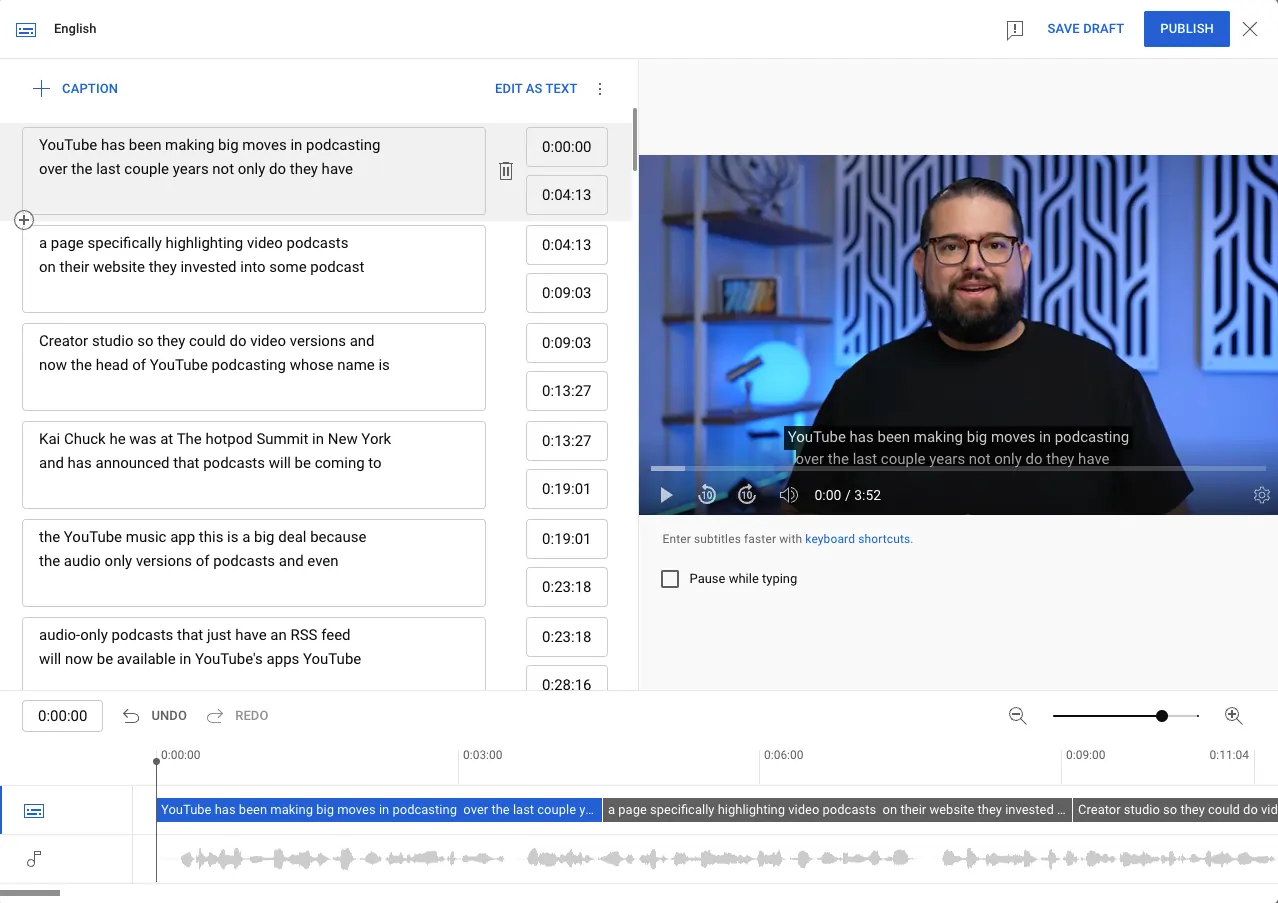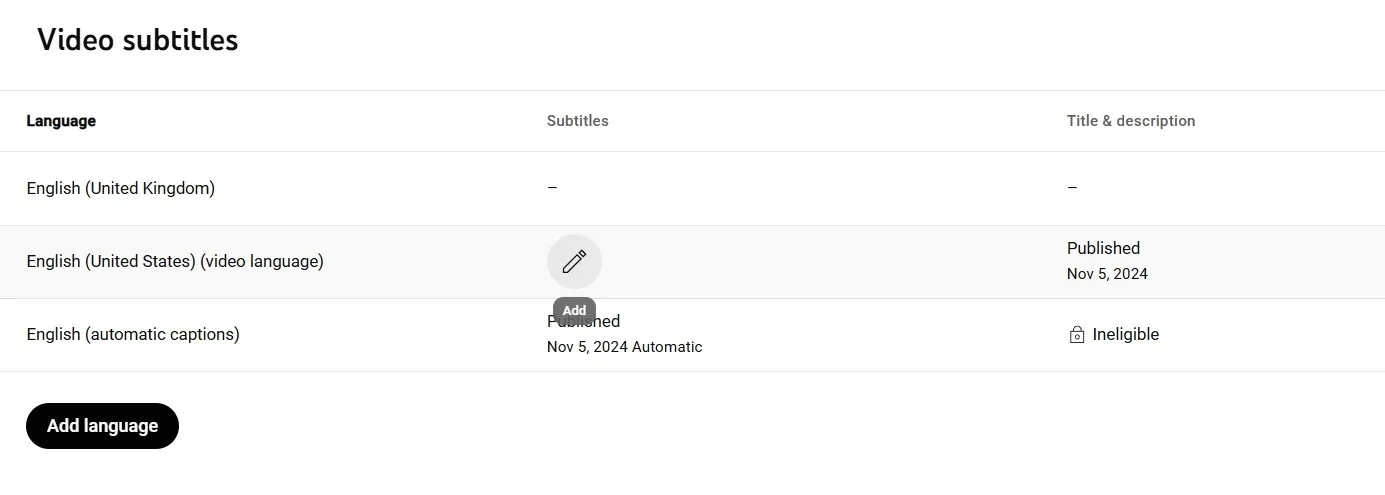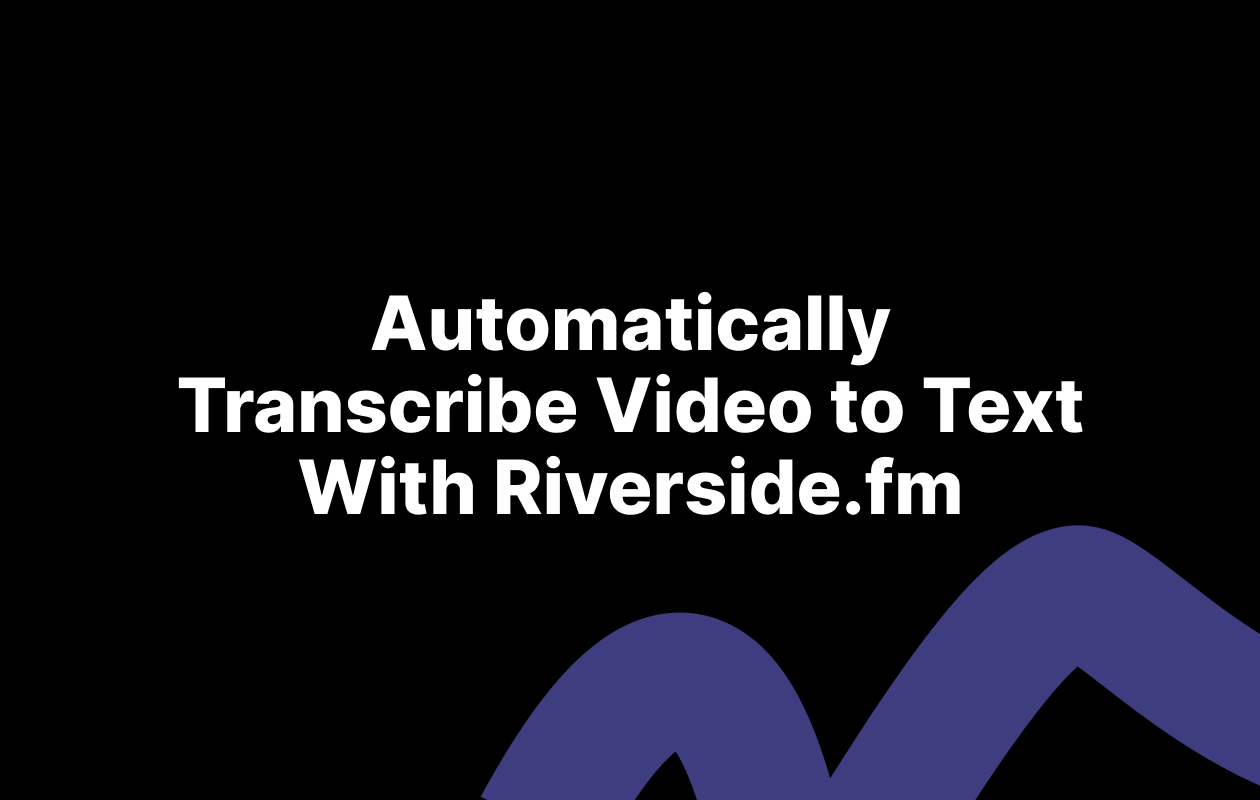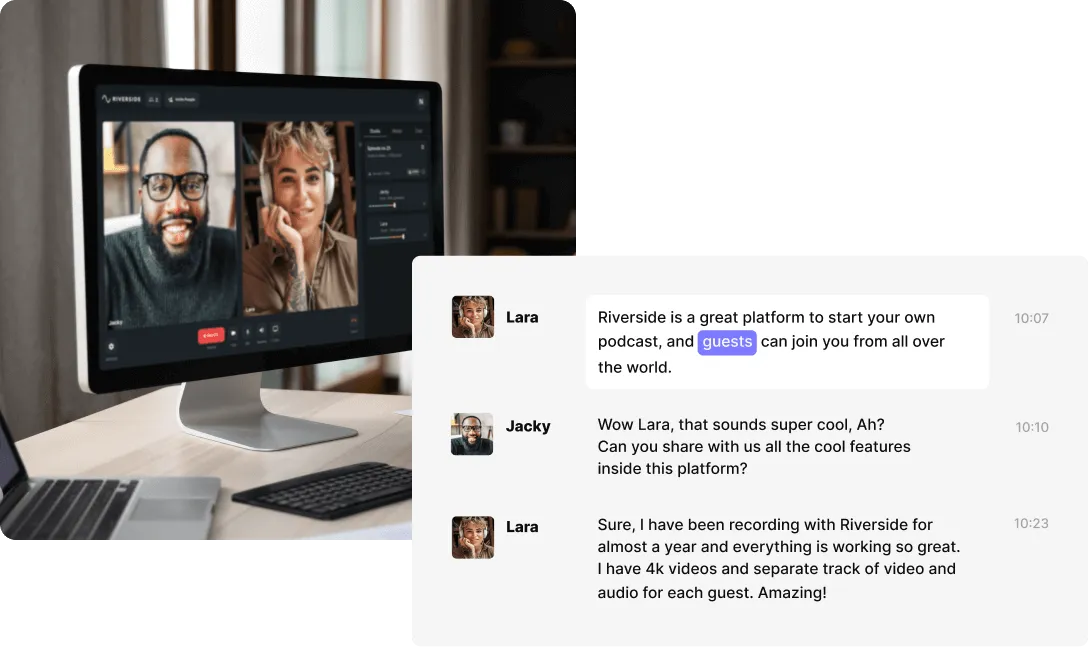Table of contents:
Why should you add captions or subtitles to videos?
How to add captions or subtitles to video (4 steps)
How to add captions to a video: 7 easy methods
Adding captions and subtitles to videos with Riverside
How to add captions and subtitles for free without a watermark
How to add closed captioning to a video on YouTube
How to add captions to a TikTok video
How to add captions to a video on Instagram
How to add captions and subtitles with Google Drive
Key takeaways:
- Captions boost accessibility, engagement, and video discoverability.
- You can add captions to a video with manual transcription or, using an automatic transcription tool to speed things up.
- Manual transcription is better for low-quality audio and difficult accents.
- Automatic transcription software like Riverside is better for fast, easy, and accurate transcripts.
Did you know that more than 75% of people watch social media videos with the sound turned off? That’s how important captions and subtitles are in reaching a broader audience.
If you’re looking to level up your content, make it more accessible, and boost your video’s discoverability, it’s time you learn how to add captions to your videos.
Read on to learn the basics of captions and subtitles, how to add them to your videos, and the best (free) tools to help you do it.
Why should you add captions or subtitles to videos?
The key benefit of adding captions or subtitles to your video is that it will help you reach more people. Let’s dig into the details of how this works.
Increased accessibility
Some people can’t perceive your content without captions, so including them in your videos helps make it accessible to all your viewers, including people who are deaf or hard of hearing.
In fact, of the 48 million people in the U.S. who are hard of hearing or deaf, only 1% use American Sign Language (ASL). That makes captions an essential way to reach this audience.
You can also reach a larger international audience by adding captions to your videos. Non-native English speakers can follow along with your video more easily if they have captions to reference. Plus, YouTube and other software can be used to translate your English captions into other languages, opening up your content to a whole new audience.
Higher engagement for silent viewers
How often do you scroll through your Instagram feed, casually watching reels with the sound off? Or maybe you’re on a busy metro, not wanting to disturb others as you quickly glance at a few funny YouTube Shorts.
“Somewhere between 70 and 80% of people actually watch videos with no sound on,” says Steve Armato, Founder Lark Media and Content Creator for SportsGridTV. “So if you want to keep people engaged, you put captions on it. It’s really that simple.”
Better discoverability
Captions and transcripts can help make your video more discoverable, both on Google and other platforms. Search engines crawl for text, not video content, so having a text version of your video content may increase its performance by making it more likely to found on the platform where it is hosted.
“Like your bio, your captions are another sweet spot to include relevant keywords on Instagram, says marketing guru Neil Patel. “When you use keywords in your captions, you’re more likely to appear in the search results when people search for those keywords.”
How to add captions or subtitles to video (4 steps)
Before we get into specific platforms, here is a general step-by-step on how to add captions to videos.
Step 1: Record your video in top-quality
The first and best thing you can do to create high-quality captions for your video is to record your audio in the highest quality possible. The clearer your audio, the better your transcription accuracy. Recording in a quiet space without background noise and using a good microphone helps.
You’ll also need high-quality recording software. This is why we suggest recording with a platform like Riverside. You can seamlessly record in 48 kHz audio for crystal-clear sound quality. (When you’re done, Riverside will automatically create a transcript for you too!)
Step 2: Generate your transcripts and captions
When it comes to transcription, you have 3 options:
- Type them up yourself (tedious)
- Human transcription services (expensive)
- Automated transcription (fast and easiest)
Human transcription services can provide you with very accurate captions or subtitles, but the costs can add up quickly. For speed and convenience, we recommend automated transcription. Riverside uses AI-powered transcription to produce a 99% accurate transcript (in 100+ languages) as you record. Or, upload your video to our automatic transcription tool to get an immediate transcript.
Step 3: Edit and style your caption or subtitle transcripts
Everything starts with a good transcript. That’s why proofreading and editing it is so important before you style your content into captions or subtitles.
Here are a few things to remember when editing your transcripts:
- File formatting: Choose a transcription format that includes timestamps and differentiates between speakers, such as SRT files.
- Styling guidelines: Check out what style guidelines you need to follow, such as how to punctuate, how many characters to include per line, or how to display auditory sounds other than dialogue.
- Translation: Translate your subtitle and caption transcripts to reach an international audience. Riverside can translate your subtitles into 100+ languages. (YouTube can translate them too, but its accuracy varies.)
With Riverside, you can create SRT files automatically, edit them as you wish, and upload them to your video sharing platform of choice. Easy!
Step 4: Export and upload your captions or subtitles
Once you finish editing your captions and subtitles, export them (in the appropriate file format).
If you’re creating open captions, you must burn them into your video. You can easily do this using a video editor that automatically generates them, like Riverside.
On the other hand, if you’re creating closed captions, you’ll have to upload the captions’ file alongside your video on your sharing platform.
We’ll walk you through a few of these in our different methods of adding captions and subtitles to videos.
Read: Closed Captions vs. Open Captions: Which Is Best for Videos?
How to add captions to a video: 7 easy methods
We’ve covered the basics, so we’ll get into the specifics. Below we cover 5 different ways to create and add captions or subtitles to videos based on different platforms.
Adding captions and subtitles to videos with Riverside
Riverside is a top-quality video creation software that also offers built-in transcription features for quick, accurate captioning. Here are some of Riverside's best features:
- Instant transcription: Automatically generate highly accurate, AI-powered transcriptions as you record.
- Multi-language support: Transcribe in more than 100 languages to reach a large international audience.
- High-quality audio recording: When you record in top-quality 48 kHz audio with automatic background noise removal, you can expect crystal-clear recordings for even more accurate transcripts.
- Customizable caption formatting: Easily customize font, color, and placement to increase your captions’ readability, and match them to your video’s unique style.
- Simple text-based editing: Make precise edits by simply editing the transcription text within the editor, cutting and adjusting your video at the same time.
- Open and closed captioning: Add, edit, and style open captions directly in our editor. Or, download an SRT file for closed captions or a TXT file for repurposing your transcript.
How to add open captions to videos with Riverside:
Step 1: After recording a video on Riverside, select the video you want to create captions for in the Studio Recordings dashboard. (Learn how to record here.)
Step 2: Click “Go to editor” to edit your video. You can also repurpose your recording into short, shareable videos with Magic Clips first, then hover over one to “Edit.”
.webp)
Step 3: In the editor, adjust your video. You can:
- Trim your video by editing your text transcript.
- Customize your background and layout.
- Add music, images, and text overlays from our royalty-free Media Board, or upload your own.
- Fine-tune your audio and remove background noise automatically using our Magic Audio feature.
Step 4: When you finish editing, select the “Captions” button from the right toolbar. This is for creating open captions directly on your video. You can style your video captions and drag them around your video to position them as you want.
.webp)
Step 5: Once you’re done, export your video with ready-made captions by clicking on the purple “Export” button on the top right corner of the screen.
How to add closed captions to videos with Riverside:
Step 1: Just like above go to your Studio recordings and select the video you want to download captions for. (Learn how to record here.)
Step 2: You'll see a preview of your transcript on the recording page. Go to “Recording Files,” find the transcript file, and click “Download.” (Note that this is only available on Pro & Business plans)
Step 3: Choose to download a Subtitle (SRT) or text Transcription (TXT) file. We suggest selecting an SRT file, which includes timestamps that are perfect for video captioning. You can upload this file along with your video directly to platforms like YouTube.
.webp)
Step 4: Proofread your transcripts and stylize them as you want before uploading them to your platform of choice.
If you don't have a Pro or Business plan, you can try our free AI transcription tool to quickly create and download transcript files.
How to add captions and subtitles for free without a watermark
You can add captions to a video for free on most video-sharing platforms. Some sites such as YouTube use AI technology to auto-generate captions for video content when you upload it. You can then download the SRT file and edit it in any text editor (like Windows Notepad or TextEdit on macOS) to fix mistakes and typos.
Alternatively, you can use a subtitle software or app like Kapwing or CapCut, which provide free captioning options with no watermark as long as you stay within their basic, no-cost plan limits.
How to add closed captioning to a video on YouTube
You can generate captions on YouTube directly, or you can upload your own transcript file to add them to your videos.
If automated captions are available for a video, YouTube already adds them without doing anything extra. We suggest proofreading these, though, as YouTube’s AI can make mistakes.
You can review YouTube’s automated captions by following these steps:
Step 1: Go to YouTube studio and select “Content” from the menu on the left.
Step 2: Upload a new video by selecting the “Videos” tab and clicking on the “Upload videos” button.

Step 3: Once your video has been uploaded, select “Subtitles” from the menu on the left, then select the video you just uploaded.
Hover on “Published,” then click on the pencil icon, “Duplicate and edit.”

Step 4: Edit and adjust your transcripts. You can view your transcript in a text format by selecting “Edit as Text,” or you can view timestamps with “Edit Timings.”

Step 5: When you finish editing, select “Publish” to add the polished captions or subtitles to your video.
You can then delete the original automated subtitles.
Voila. Automatic captions on your YouTube videos. Want to add your own transcripts instead?
Follow these steps to add captions or subtitles to YouTube manually:
Step 1: Go to YouTube studio and select “Subtitles” from the menu on the left.
Step 2: Choose a video you’d like to add captions or subtitles to.
Step 3: Click on “Add Language” and choose what language you’d like your captions or subtitles to be. You can always generate translations of your original transcript to add other languages.
Step 4: Hover on the empty slot under “Subtitles,” then click on the pencil icon “Add.”

Step 5: Select how you’d like to add captions.
.webp)
You can either:
- Upload File: This is if you already have your own transcripts. You can upload caption and subtitle transcripts with or without timestamps. (Riverside can do both.)
- Auto Sync: You can type out or upload your own file. YouTube will automatically sync these captions to your video.
- Type Manually: You’ll type out captions by hand. YouTube has some shortcuts to speed up this process.
- Auto translate: This is for translating subtitles and captions. YouTube can do this automatically, or you can upload in different languages to suit your audience’s needs.
When you click “Add” for the second set of subtitles, the Auto Translate feature should become available to translate your subtitles automatically.
.webp)
Step 6: Review your captions and subtitles, then press “Publish” when your captions and subtitles are ready.
How to add captions to a TikTok video
As one of the most popular social media for video sharing, it’s no surprise TikTok has implemented its own auto-captions feature. Note that while you can edit these subtitles, you cannot upload an SRT file with timestamps.
Also, just like YouTube’s automated captions, TikTok is prone to errors as well, so it’s best to check the results before posting.
Here’s a quick tutorial on how to add captions on TikTok:
Step 1: Record or upload your TikTok video. Once you're done, tap the red check button or the next button, and on the menu on the right side of the screen, click on the “Captions” option and turn them on. TikTok will automatically generate subtitles for your video.
.webp)
Step 2: Once your captions are ready, they will appear at the bottom of the screen. You can edit them by tapping the text or scroll them by tapping the “Play” button after each line. Once you’re done, click “Save” to finalize.
.webp)
How to add captions to a video on Instagram
Like the other social platforms, Instagram has its own built-in auto-captioning tool. However, Instagram subtitles are not very precise, so it’s always better to edit them before publishing your content.
Just like TikTok, you cannot upload an SRT file if you are looking for timestamped closed captions.
Here’s a quick tutorial on how to add captions to Instagram reels:
Step 1: Record a new reel. After you’re done, click on the "CC" captions button.
You can also select the stickers icon at the bottom of your screen (it's a smiling square sticker).
From the new menu that pops up, select the “CAPTIONS” option and automatic subtitles should appear in a few seconds.
.webp)
Step 2: Style your automatic captions by clicking on the buttons at the bottom, or edit the text by clicking on it.
As soon as your automatic Instagram captions are ready, use the menu bar at the bottom of your screen to select a font and format style. When you’re finished editing, select “Done.”
How to add captions and subtitles with Google Drive
Although Google Drive is more of a storage platform, you can still use it to share videos with a selected group of people.
Google Drive offers automated captions and subtitles, but you can also add your own. Note that the quality of auto-captions is the same as YouTube, since it’s effectively the same tool.
Follow these steps to add captions and subtitles to Google Drive videos:
Step 1: Log in to Google Drive and upload the video you’d like to add captions or subtitles to.
Step 2: Click on the video. Then, on the top right, select the three-dot menu for “More Actions.”
Step 3: Select “Manage caption tracks,” which will redirect you to a new tab for editing and adding captions to your Google Drive videos.
.webp)
Step 5: From the right menu, click “Add new caption tracks” if you want to upload your own captions, or “Generate automatic captions” if you want to auto-generate them.
.webp)
Step 6: If you generated your captions automatically, they will be added to your file in a few moments.
If you want to use your own, click upload or select your caption or subtitle transcript in a compatible format, such as an SRT file. Choose the language of your captions and title it if you’d like, then select “Upload” to complete the process.
.webp)
How to add captions and subtitles to videos on your phone
If you’re on the go, you may want to add captions or subtitles to videos from your phone.
If you’re working with closed captions, simply use a transcription generator and upload it to your sharing platform along with your video. If you’re using open captions, try a video editor.
Since manual transcriptions might take a long time, we suggest using a video editing app with built-in captioning. You can use these on both Android and iPhone. For example, you can try CapCut, a very popular video editing app.
Follow these steps to add automated captions or subtitles on Android and iPhone using CapCut:
Step 1: Add a New Project or select an existing video project to add captions or subtitles to.
Step 2: Upload your video, crop it if you wish, then select “Add.”
Step 3: Select the “Captions” button at the bottom of the screen. Then select “Auto Captions.”
.webp)
Step 4: Select if you want to transcribe voiceover, original sound, or both. If you have a Pro account, you can also choose your captions’ language and styling, add bilingual languages, and decide whether you want CapCut to delete filler words automatically.
.webp)
Step 5: After adjusting settings, select “Generate,” and captions will automatically generate.
Step 6: Edit and review your captions, then select “Done.” You can style your captions and change their font or give them effects to make them stand out.
Step 7: When you’ve edited enough, press the upward arrow on the top right to "Export" button to download your video.
.webp)
If you don’t want to use CapCut, other viable options are Clips and iMovie (although you'll have to write your subtitles manually) for iPhone, and Submagic and Zubtitle for Android.
Final Thoughts
Most social platforms have features that make it easy to add subtitles and captions on their sites. When you add them to your videos, you expand your audience and increase the reach and discoverability of your content.
And remember, if you want to add accurate captions and subtitles quickly and easily, choosing Riverside is a no-brainer. In fact, you can use it for all your captioning needs, and easily save your videos in the right formats for various platforms. Try it for free today.
FAQs on How to Add Video Subtitles and Captions
Do you still have questions? Our FAQ section has answers for some of the most commonly asked questions about video captions and subtitles.
What’s the difference between captions and subtitles?
Although you’ll often hear people referring to captions and subtitles interchangeably, the two are not exactly the same. The major difference lies in what aspects of the audio they convey.
- Subtitles only capture dialogue. Their principal use is in the translation of foreign language videos and film. As a result, the way subtitles are formatted is based on the assumption that the viewer can also hear the audio.
- Captions convey all the audio in a video beyond just dialogue and include sound effects and other non-speech sounds. They are designed to accommodate those who cannot hear any audio at all. Captions can be open or closed.
- Open captions are always visible, and viewers cannot turn them off.
- Closed captions’ visibility is adjustable. Viewers can switch them on or off, depending on their preference.
How can I add subtitles to a video without any software?
Some social sharing sites like YouTube, Instagram, or TikTok will automatically provide subtitles for videos (check our full guides above).
However, if you need to add them yourself, you can do so by typing them out and then uploading them alongside your video. It will take some time, but you can do all of this without downloading any type of software.
How to add subtitles to a video permanently?
You have to use video editing software to hardcode subtitles into your video file to permanently add subtitles. These are called closed captions.
How to add subtitles to a video in VLC?
VLC Media Player is an open-source multimedia player that includes basic editing features, including the ability to add subtitles. There are two ways to add videos in VLC. The first way lets you add them so that they’re only visible within the VLC program. The second way hardcodes them into the video file so that they will display no matter where you play or upload your video file.
Here are step-by-step instructions for how to add them in the second, more permanent way.
Step 1: Open VLC player.
Step 2: Select “Media” from the upper left corner of the screen and choose “Stream” from the dropdown menu.
Step 3: In the pop-up window, click the “+ Add button” and select the video file on your computer.
Step 4: Click the “Use a subtitle” field in the popup window.
Step 5: Click browse and select the SRT file from your system.
Step 6: Click “Stream” and then “Next.”
Step 7: In the Stream Output window, choose “File” from the dropdown and then click the “Add” button.
Step 8: In the pop-up window, click “Browse” and create a name for your video. Be sure your file name ends with the file format type you prefer.
Step 9: Choose the folder where you want to save your video and click “Save” and then “Next.”
Step 10: Check the “Activate Transcoding” box and then click the “Wrench” icon.
Step 11: Navigate to the “Subtitles” tab and check the “Subtitles” and “Overlay subtitles on the video” boxes.
Step 12: Click “Save” and then “Next.”
How do I get captions from a video?
To get captions from a video, you can download from video platforms with automatic captioning, like YouTube. Just go to the “Subtitles” tab of your YouTube studio, select the video you want to download the captions from, then hover on Published on the automatic captions row. Click on the three dots “Options” icon, then click “Download.”
Alternatively, you can use Riverside to automatically transcribe all your recordings. Then, all you need to do is download your transcripts or subtitles from your Recordings page in the Riverside studio.
How accurate are auto-generated captions?
The accuracy of auto-generated captions depends on the platform used and the clarity of the audio. In ideal conditions (e.g. minimal background noise, clear and slow speech, no strong accents, and high-quality audio) most AI-driven tools can achieve around 80-90% accuracy.
Riverside offers even higher accuracy. By using an advanced speech recognition algorithm and recording directly on the device, Riverside can transcribe in 100+ languages with 99% accuracy.


.webp)




















